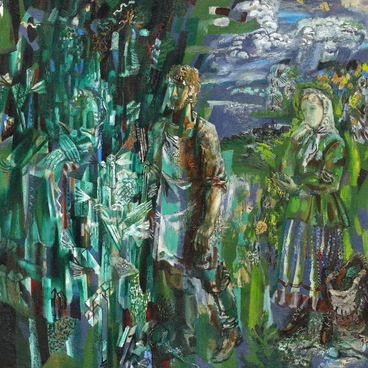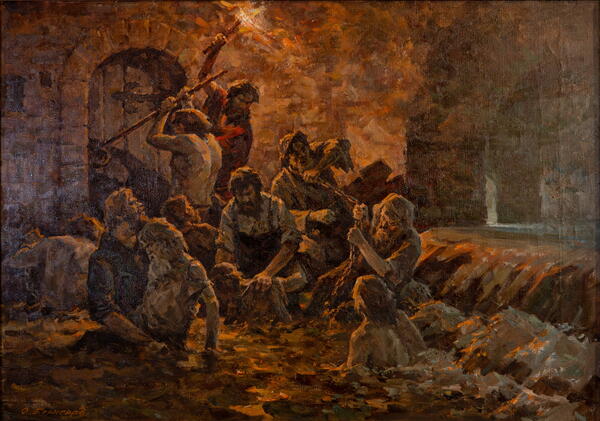Oleg Edgardovich Bernhard was a Ural artist of German ancestry. He was born in Munich, but at the age of five, moved to Yekaterinburg, Russia, together with his parents. His mother was a famous pianist, and as a child, Oleg Bernhard studied music. However, eventually, he decided to become a painter. He dedicated most of his works to the landscape genre. Bernhard studied under respectable teachers, including Leonard Turzhansky, a recognized master of the lyrical landscape style. He taught Bernhard to work with colors, perceive nature, and choose subjects for his paintings. However, unlike Turzhansky’s heartfelt and impressionistic paintings, Bernhard’s landscapes were characterized by directness, simplicity, and relatability. These words can be used to describe the 1979 painting titled “Time of Harvesting. The Work Is Over”.
The artist did not stop at the image of nature. In the foreground, against the backdrop of his favorite landscape, he placed the main character of the picture — a middle-aged village worker and harvester operator who seems well aware of the importance of his work. He harvests grain and is depicted next to his machine, which has five red stars painted on it. In the 1960s, Soviet collective and state farms had a tradition of using such starts to distinguish the highly productive workers judging by the number of hectares they cultivated during a grain harvest or record tons of wheat they threshed. Thus, each thousand tons of grain they processed was marked by one red star on their agricultural machinery.
The artist glorifies the character with the help of composition, emphasizing the importance of the harvester operator through the scale of his figure and the confident posture. In the background, Bernhard depicted the final stage of the grain harvesting process, hence the name of the canvas. Open-cab harvesters resembling the SK-4 are shown moving across the golden field. A ZiL truck rides nearby, and grain is poured from the bunker into its bed. Such machines were produced by one of the oldest automobile manufacturing enterprises in the country — the Moscow Likhachov Plant — and were often used in Soviet agriculture. They transported grain from combines to elevators.
The beautiful golden ocher color palette of the painting reflects the atmosphere of a fine sunny day and also shows a rich harvest as symbolizing the results of the union of people and mighty nature.
The artist did not stop at the image of nature. In the foreground, against the backdrop of his favorite landscape, he placed the main character of the picture — a middle-aged village worker and harvester operator who seems well aware of the importance of his work. He harvests grain and is depicted next to his machine, which has five red stars painted on it. In the 1960s, Soviet collective and state farms had a tradition of using such starts to distinguish the highly productive workers judging by the number of hectares they cultivated during a grain harvest or record tons of wheat they threshed. Thus, each thousand tons of grain they processed was marked by one red star on their agricultural machinery.
The artist glorifies the character with the help of composition, emphasizing the importance of the harvester operator through the scale of his figure and the confident posture. In the background, Bernhard depicted the final stage of the grain harvesting process, hence the name of the canvas. Open-cab harvesters resembling the SK-4 are shown moving across the golden field. A ZiL truck rides nearby, and grain is poured from the bunker into its bed. Such machines were produced by one of the oldest automobile manufacturing enterprises in the country — the Moscow Likhachov Plant — and were often used in Soviet agriculture. They transported grain from combines to elevators.
The beautiful golden ocher color palette of the painting reflects the atmosphere of a fine sunny day and also shows a rich harvest as symbolizing the results of the union of people and mighty nature.


